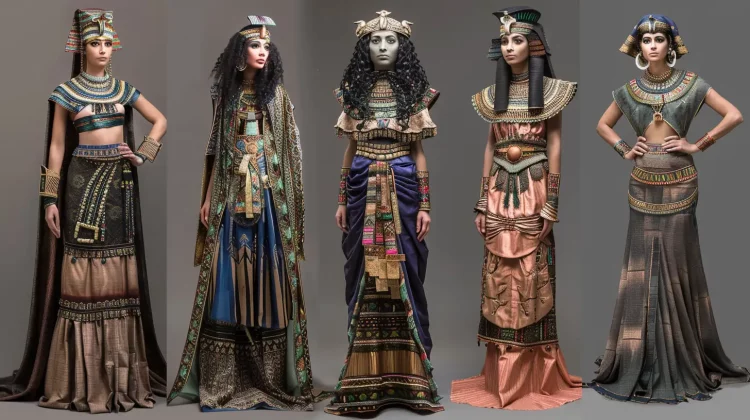Clothing has always held deep cultural, spiritual, and societal significance. Beyond simply serving as protection from the elements, clothing can communicate social status, cultural identity, gender roles, and even spiritual beliefs. Throughout history, the garments worn by ancient civilizations were carefully crafted with symbolic meanings, reflecting the values, beliefs, and traditions of the people who wore them. This article delves into the rich symbolism behind ancient clothing, exploring how fashion in ancient societies went far beyond aesthetics and played a crucial role in defining identity, power, and spirituality.
The Role of Clothing in Ancient Societies
In ancient civilizations, clothing was not only functional but also deeply symbolic. In many cultures, garments were designed to express social hierarchy, status, and role within the community. For example, the materials, colors, and styles of clothing worn could immediately indicate one’s social standing, occupation, or religious affiliation. In some cases, clothing was also seen as a tool for spiritual expression or protection.
For instance, in ancient Egypt, the attire of the Pharaohs was symbolic of their divine status. The elaborate headdresses, linen garments, and ceremonial jewelry were not only for adornment but were intended to display the ruler’s connection to the gods. These garments were also thought to protect the wearer from evil forces and ensure their power and legitimacy.
Similarly, ancient Rome saw clothing as a status symbol, with particular emphasis placed on the tunic and toga. Roman citizens were recognized by their attire, with certain colors and patterns signifying different social ranks. The tunic, often made from wool or linen, was the standard dress for both men and women, while the toga was reserved for Roman citizens, particularly the elite and political leaders. The toga’s distinctive folds were symbolic of Roman citizenship and political involvement.
Symbolism in Ancient Egyptian Clothing
In ancient Egypt, clothing was intricately tied to spiritual beliefs and the desire for the protection of the gods. Linen, a light and breathable fabric, was the preferred material for clothing, as it was associated with purity and the divine. For the Pharaohs, elaborate headdresses, such as the iconic crowns of Upper and Lower Egypt, symbolized their control over both parts of the kingdom. Pharaohs would also wear jewelry crafted from gold, lapis lazuli, and turquoise, which were considered powerful protective symbols.
The white kilt or shendyt, worn by both men and women, symbolized purity and strength. Additionally, ankh necklaces and scarab amulets were worn as symbols of eternal life and protection. These powerful symbols were believed to connect the wearer to the gods and to ensure favor in the afterlife.
Clothing also signified the social order in Egyptian society. For example, priests wore fine linen and ceremonial garb to signify their closeness to the gods, while workers and laborers wore simpler, rougher garments. The clothing of the ancient Egyptians not only indicated one’s status within the society but also was a means of aligning oneself with divine order.
The Significance of Color in Ancient Garments
Colors were highly symbolic in many ancient cultures. In ancient China, for instance, the color of one’s clothing held deep meaning. Red was seen as a color of good fortune and happiness, often worn during festivals and celebrations. The yellow robes of the emperor symbolized the ruler’s connection to the Yellow Emperor and were reserved for imperial use. Wearing yellow was forbidden for the common people, making it an exclusive signifier of imperial authority.
In ancient Greece, color also played an important role in the symbolism of garments. The famous chiton, a tunic worn by both men and women, could be made of wool or linen and came in various colors. Purple, however, was the color most associated with royalty and the upper classes. This was due to the labor-intensive process of extracting purple dye from sea snails, making it extremely rare and expensive.
In ancient India, clothing was also a visual expression of spiritual beliefs. The sari, a traditional garment worn by women, was often dyed in bright, symbolic colors such as red for fertility and marriage, and yellow for auspiciousness and spirituality. Indian clothing, particularly the use of saffron and white, also reflected the connection to Hindu beliefs, with saffron symbolizing purity and renunciation, and white representing peace and simplicity.

Ceremonial and Sacred Clothing
In many ancient cultures, clothing played a key role in religious ceremonies and rituals. In ancient Mesopotamia, the garments worn by priests during religious rites were often adorned with symbols that represented the divine. These garments were seen as a conduit through which the gods could be honored and communicated with. The priests of the gods in Mesopotamia would wear ceremonial robes made from fine wool and adorned with gold thread to convey the sacredness of the ceremony.
Similarly, ancient Mayan and Aztec clothing was often ceremonial, with garments made from cotton, feathers, and jade being worn during religious festivals. For the Mayan elites, elaborate headdresses made from feathers and jade represented their connection to the gods and their ability to mediate between the divine and earthly realms.
The Inca Empire placed great importance on the ceremonial aspect of clothing. Inca rulers were known for wearing mantles and tunics that displayed their wealth and connection to the divine. These garments were decorated with intricate gold embroidery and symbols of the sun, as the sun god was considered the primary deity in Inca culture. The Inti (sun) was believed to give life and power, and wearing clothing adorned with symbols of Inti was a sign of the wearer’s divine mandate.
Fashion as a Reflection of Social Status and Power
Ancient clothing was often a direct reflection of an individual’s status, power, and authority. The more elaborate and intricate the garment, the higher the social position it indicated. For instance, the Roman toga was a symbol of Roman citizenship and social hierarchy. It was an important visual indicator of one’s political standing, with tunic color and toga design showing whether the individual was a citizen, a political leader, or part of the ruling class.
In ancient Persia, kings and noblemen wore richly embroidered garments made from silk and decorated with precious stones to signify their high social status. Persian royals were often depicted in elaborate clothing in artwork, which showcased their wealth and power over the empire. Their clothing reflected not only their physical strength but also their divine right to rule.
Similarly, in medieval Europe, kings and queens adorned themselves with luxurious fabrics such as velvet, brocade, and furs. These materials were often so expensive that only the nobility could afford them. In fact, laws were sometimes enacted to regulate the type of clothing worn by different social classes, with sumptuary laws dictating that only royals and nobles could wear certain colors or materials.
The Spiritual Protection of Clothing
In many ancient cultures, clothing was thought to serve a protective function, shielding the wearer from negative influences or evil forces. In ancient Egypt, the use of amulets and talismans in clothing was common, especially among the elite. These protective symbols, often sewn into the fabric or worn as jewelry, were believed to bring the wearer divine protection, safeguard against illness, and ensure success.
In ancient Greece, the use of ritual clothing in religious ceremonies was thought to bring the wearer closer to the gods. Sacred garments, worn during festivals honoring deities, were believed to enhance the individual’s spiritual connection and invite the gods’ favor. For instance, women would wear the peplos, a sacred garment worn in honor of Athena, the goddess of wisdom.
Conclusion: Ancient Clothing as Cultural Expression
Ancient clothing goes far beyond its basic function of covering the body. Throughout history, clothing has been a symbol of culture, status, spiritual beliefs, and societal structure. From the elaborate robes of Egyptian Pharaohs to the ritual garments of Incan priests, the clothes people wore served as expressions of power, identity, and faith. The use of color, material, and ornamentation in ancient clothing reveals deep insights into the values and beliefs of different civilizations, making clothing an essential part of understanding the history and culture of ancient societies.
By examining the symbolism behind ancient clothing, we gain a richer understanding of how cultures communicated their values and connected with their spiritual and social worlds. These garments, now preserved in museums and collections, continue to tell the story of human history and the timeless desire to express oneself through clothing.





















